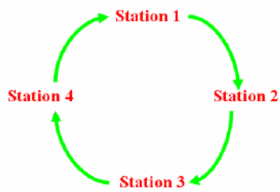Problem-Solving Carousel
The teacher creates heterogeneous groups and sets up enough stations around the classroom to accommodate groups of 3-4 students each. Each station has a different multi-step problem written on a large whiteboard or piece of chart paper.
Groups are assigned to a station and begin working together to solve the problem written there (DOK 2). Time is called shortly after they begin working and teams move to the next station where another group has begun to solve a different problem. Each group discusses what they see in their peer’s work and decides if the last group was or was not correct up to that point. They then continue the task if correct and make corrections if not (DOK 1, 2). In the last round, groups develop a justification around the correct solution (DOK 3).
This carousel strategy can be used with many different content areas (e.g., building upon the ideas of others through progressive group writing). Strategies such as these promote deeper discussions and collaborative reasoning even when assignments begin with a very basic task, such as solving routine math problems or developing a summary of the text.

Source
Hess, Karin. A Local Assessment Toolkit to Promote Deeper Learning. Corwin, 2018, p.28.
